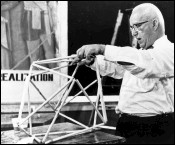An Introduction to Synergetics
Readings | Topics
| Domes | Map | Links
![]()
Synergetics is a philosophy wherein geometric concepts serve as central metaphors.
Scenarios, perhaps rendered as computer animations, provide a glue language, a visual vocabulary serving to complement the thousand-plus, often densely worded passages.

R. Buckminster Fuller intended to include more pictures in the original two volumes than eventually made it to the final cut. Those that remain play a central and expository role, and much of the discussion surrounding them describes their dynamic or transformational aspects.


